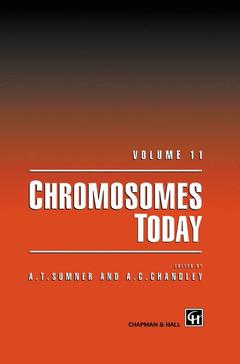Description
Chromosomes Today, Softcover reprint of the original 1st ed. 1993
Volume 11
Coordinators: Sumner A.T., Chandley A.C.
Language: English
Subjects for Chromosomes Today:
Keywords
Chromosome; DNA; Interphase; Mutation; PCR; Telomere; Termination; Vivo; evolution; gene expression; genes; genome mapping; hybridization; molecular biology; recombination
Publication date: 11-2012
406 p. · 15.5x23.5 cm · Paperback
406 p. · 15.5x23.5 cm · Paperback
Description
/li>Contents
/li>
When the late Professor C. D. Darlington founded what developed into the International Chromosome Conferences in Oxford in 1964, he was concerned that scientists who worked on different aspects of chromosomes, or who studied them in different ways, should have the opportunity of "discussing the fundamental problems of chromosomes with one another". The fact that well over 300 scientists with a wide variety of interests came to Edinburgh in August 1992 for the 11th International Chromosome Conference shows that there is still the same need, and also the desire among chromosomologists to have such discussions. The present volume contains almost all the invited contributions, and attests to the diversity of approaches and applications in chromosomal studies. A few years ago it may have seemed to some that chromosome studies were being superseded by molecular biology, but the molecular biologists have now realized that they need to know about chromosomes, and indeed an important, if ill-defined discipline of 'molecular cytogenetics' has grown up in recent years. We are pleased that in planning the Conference and this book, so much of the work presented is at the interface between cytogenetics and molecular biology. This will surely continue in the future, as boundaries between disciplines are largely artificial, and each has much to learn from the others.
Opening Lecture.- 1 From chromosome number to chromosome map: the contribution of human cytogenetics to genome mapping.- Chromosome Structure.- 2 Molecular cloning and characterization of human centromeric autoantigen CENP-C: a component of the inner kinetochore plate.- 3 Characterization of the telomeric region of human chromosome 16p.- 4 The vertebrate genome: isochores and chromosomal bands.- The Nucleolus.- 5 Ribosomal genes and nucleolar morphology.- 6 Nucleolar proteins during mitosis.- 7 Ribosomal RNA gene expression and localization in cereals.- 8 Compartmentalization of the cell nucleus: case of the nucleolus.- Evolution.- 9 Chromosomal divergence and speciation in grasshoppers.- 10 Chromosomal variation in theSceloporus grammicuscomplex (Sarnia, Phrynosomatidae).- Cancer.- 11 Deletions of chromosome 5 in malignant myeloid disorders.- 12 Chromosomal abnormalities in solid tumours.- 13 Non-radioactivein situhybridization to metaphase and interphase nuclei of malignant cells.- Genome Analysis.- 14 Microdissection of GTG-banded chromosomes and PCR-mediated cloning.- 15 Molecular cytogenetics — biology and applications in plant breeding.- 16 Molecular organization of genes and repeats in the large cereal genomes and implications for the isolation of genes by chromosome walking.- 17 Fragile sites and unstable elements.- 18 The ‘AZF’-function of the human Y chromosome during spermatogenesis.- Sex Chromosomes.- 19 Unpaired sex chromosomes and gametogenic failure.- 20 Mammalian sex determination: what we have learnt from a chromosomal design fault.- 21 Evolution of the mammalian XY pairing segment.- Meiosis and Aneuploidy.- 22 The questionable role of the synaptonemal complex in meiotic chromosome pairing and recombination.- 23 Meiotic nodules in vascularplants.- 24 The origin of non-disjunction in humans.- 25 Studies on maternal age-related aneuploidy in mammalian oocytes and cell cycle control.- 26 Minisatellite mutation and recombination.- 27 The M26 homologous recombination hotspot: sequences, factors and chromosomal context.- Imprinting and Methylation.- 28 Parental imprinting and epigenetic programming of the mouse genome: long lasting consequences for development and phenotype.- 29 Methylated DNA-binding proteins and chromatin structure.- 30 Rye B chromosome transmission depends on the B, the carrier of the B and the mother of the carrier.
© 2024 LAVOISIER S.A.S.
These books may interest you

Plant Cytogenetics 208.65 €

Plant Cytogenetics 56.31 €

Chromosomes TodayVolume 12 158.24 €

